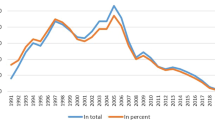Abstract
Using inter-provincial panel data from 1998 to 2012, and taking the implementation of China's new “Labor Contract Law” in 2008 as a quasi-natural experiment, this study uses the differences-in-differences empirical method to quantitatively analyze the impact of changes in labor protection intensity on local economic growth. The empirical results show that the enhancement of labor protection intensity can effectively promote economic growth in regions with higher levels of human capital, especially the eastern developed regions in China. Further research shows that this promotion effect is more obvious for the growth of the tertiary industry.

Similar content being viewed by others
Change history
11 July 2024
This article has been retracted. Please see the Retraction Notice for more detail: https://doi.org/10.1007/s10660-024-09877-8
References
Arrow, K. J., Chenery, H. B., Minhas, B. S., & Solow, R. M. (1961). Capital-labor substitution and economic efficiency. The review of Economics and Statistics. https://doi.org/10.2307/1927286
Cai, F. (2009). China’s future demographic dividend: Digging new source of economic growth. Chinese Journal of Population Science,1, 2–10.
Ni, X., & Zhu, W. (2018). The bright side of labor protection in emerging markets: The case of firm transparency. Pacific-Basin Finance Journal,50, 126–143. https://doi.org/10.1016/j.pacfin.2017.06.009
Poschke, M. (2009). Employment protection, firm selection, and growth. Journal of Monetary Economics,56(8), 1074–1085. https://doi.org/10.1016/j.jmoneco.2009.10.013
Bassanini, A., Nunziata, L., & Venn, D. (2009). Job protection legislation and productivity growth in OECD countries. Economic policy,24(58), 349–402. https://doi.org/10.2307/40272543
Conti, M., & Sulis, G. (2016). Human capital, employment protection and growth in Europe. Journal of Comparative Economics,44(2), 213–230. https://doi.org/10.1016/j.jce.2015.01.007
Harcourt, M., & Wood, G. (2007). The importance of employment protection for skill development in coordinated market economies. European Journal of Industrial Relations,13(2), 141–159. https://doi.org/10.1177/0959680107078247
Chen, D., Hu, Q., & Liang, Y. (2014). Labor protection, business resilience and bank deposit contract. Financial and Economic Journal,40(9), 62–72.
Serfling, M. (2016). Firing costs and capital structure decisions. Journal of Finance,71(5), 2239–2286. https://doi.org/10.1111/jofi.12403
Acharya, V. V., Baghai, R. P., & Subramanian, K. V. (2013). Wrongful discharge laws and innovation. The Review of Financial Studies,27(1), 301–346. https://doi.org/10.2139/ssrn.1570663
Bradley, D., Kim, I., & Tian, X. (2016). Do unions affect innovation? Management Science,63(7), 2251–2271. https://doi.org/10.2139/ssrn.2232351
Huang, P. (2013). Discharge costs, employment and industrial transformation and upgrading. Nankai Economic Research Journal,3, 79–94.
Liu, Y., & Liu, B. (2014). Labor protection, cost stickiness and enterprise response. Economic Research Journal,5, 63–76.
Cingano, F., Leonardi, M., Messina, J., & Pica, G. (2016). Employment protection legislation, capital investment and access to credit: Evidence from Italy. The Economic Journal,126(595), 1798–1822. https://doi.org/10.1111/ecoj.12212
Autor, D. H., Kerr, W. R., & Kugler, A. D. (2007). Does employment protection reduce productivity? Evidence from US states. The Economic Journal,117(521), F189–F217. https://doi.org/10.1111/j.1468-0297.2007.02055.x
Olney, W. W. (2013). A race to the bottom? Employment protection and foreign direct investment. Journal of International Economics,91(2), 191–203. https://doi.org/10.1016/j.jinteco.2013.08.003
World Bank. (2018). Labor regulations throughout the World: An overview. Working Paper, No. 16, Washington, DC.
Allen, F., Qian, J., & Qian, M. (2005). Law, finance, and economic growth in China. Journal of financial economics,77(1), 57–116. https://doi.org/10.1016/j.jfineco.2004.06.010
Ni, X., & Zhu, W. (2016). Labor protection, labor intensity and enterprise innovation. Journal of Management World,7, 154–167.
Solow, R. M. (1999). Neoclassical growth theory. Handbook of macroeconomics,1, 637–667.
Romer, P. M. (1986). Increasing returns and long-run growth. Journal of political economy,94(5), 1002–1037. https://doi.org/10.1086/261420
Manso, G. (2011). Motivating innovation. The Journal of Finance,66(5), 1823–1860. https://doi.org/10.1111/j.1540-6261.2011.01688.x
Gao, F., & Shi, L. (2009). The convergence of labor productivity growth in China’s various provinces: 1978–2006. Journal of Management World,1, 49–60.
Liu, Y. (2014). Research on the minimum wages on gender differences employment in China –Based on the analysis of China’s provincial panel data and industrial panel data analysis. Business Economics and Management,9, 86–97. https://doi.org/10.3969/j.issn.1000-2154.2014.09.010
Jin, X., & Duan, H. (2007). The relationship between human capital and regional economic development in China—Panel data analysis. Shanghai Economic Research Journal,10, 22–30. https://doi.org/10.3969/j.issn.1005-1309.2007.10.003
Zhang, Y., Xu, Y., & Wang, Z. (2010). Human capital, physical capital and output differences between China and the United states an empirical study of human capital model on panel data in 52 countries from 1981 to 2005. Finance & Trade Economics,9, 118–124.
Wang, Y., & Zhu, P. (2016). Research on the impact of human capital structure effect on regional economic growth in China. Nanjing Social Science,8, 18–25.
Athey, S., & Imbens, G. W. (2006). Identification and inference in nonlinear difference-in-differences models. Econometrica,74(2), 431–497. https://doi.org/10.1111/j.1468-0262.2006.00668.x
Beck, T., Levine, R., & Levkov, A. (2010). Big bad banks? The winners and losers from bank deregulation in the United States. The Journal of Finance,65(5), 1637–1667. https://doi.org/10.1111/j.1540-6261.2010.01589.x
Li, M., & Xu, J. (2014). Who benefits from China’s trade union? Economic Research Journal,5, 49–62.
Funding
Chongqing Social Science Foundation Project: Research on harmonious labor relations thought of socialism with Chinese characteristics in the new era (2021YBCS39); Science and technology project of Chongqing Education Commission: (KJQN202000905); Chongqing Education Commission humanities and social sciences research project(21SKGH134)/ (21 SKGH141) and (SISU202157) The 13th Five-Year Education Planning Project (2018-GX-317).
Author information
Authors and Affiliations
Corresponding author
Ethics declarations
Conflict of interest
There is no conflict of interest among the authors.
Additional information
This article has been retracted. Please see the retraction notice for more detail: https://doi.org/10.1007/s10660-024-09877-8"
Rights and permissions
Springer Nature or its licensor (e.g. a society or other partner) holds exclusive rights to this article under a publishing agreement with the author(s) or other rightsholder(s); author self-archiving of the accepted manuscript version of this article is solely governed by the terms of such publishing agreement and applicable law.
About this article
Cite this article
Xu, X., Fu, X., Gao, F. et al. RETRACTED ARTICLE: Does the increase of labor protection intensity promote regional economic growth? Evidence from China. Electron Commer Res 23, 155–173 (2023). https://doi.org/10.1007/s10660-022-09604-1
Accepted:
Published:
Issue Date:
DOI: https://doi.org/10.1007/s10660-022-09604-1




